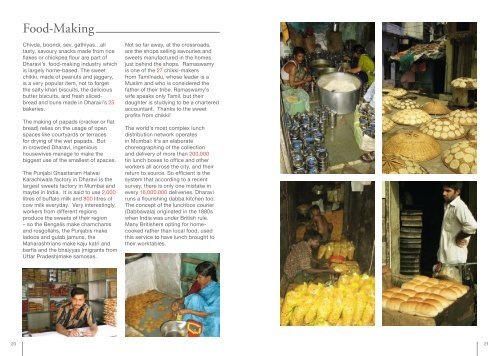ReDharavi
ReDharavi
ReDharavi
You also want an ePaper? Increase the reach of your titles
YUMPU automatically turns print PDFs into web optimized ePapers that Google loves.
20<br />
Food-Making<br />
Chivda, boondi, sev, gathiyas…all<br />
tasty, savoury snacks made from rice<br />
flakes or chickpea flour are part of<br />
Dharavi’s food-making industry which<br />
is largely home-based. The sweet<br />
chikki, made of peanuts and jaggery,<br />
is a very popular item, not to forget<br />
the salty khari biscuits, the delicious<br />
butter biscuits, and fresh slicedbread<br />
and buns made in Dharavi’s 25<br />
bakeries.<br />
The making of papads (cracker or flat<br />
bread) relies on the usage of open<br />
spaces like courtyards or terraces<br />
for drying of the wet papads. But<br />
in crowded Dharavi, ingenious<br />
housewives manage to make the<br />
biggest use of the smallest of spaces.<br />
The Punjabi Ghasitaram Halwai<br />
Karachiwala factory in Dharavi is the<br />
largest sweets factory in Mumbai and<br />
maybe in India. It is said to use 2,000<br />
litres of buffalo milk and 800 litres of<br />
cow milk everyday. Very interestingly,<br />
workers from different regions<br />
produce the sweets of their region<br />
– so the Bengalis make chamchams<br />
and rosgollahs, the Punjabis make<br />
ladoos and gulab jamuns, the<br />
Maharashtrians make kaju katri and<br />
barfis and the bhaiyyas (migrants from<br />
Uttar Pradesh)make samosas.<br />
Not so far away, at the crossroads,<br />
are the shops selling savouries and<br />
sweets manufactured in the homes<br />
just behind the shops. Ramaswamy<br />
is one of the 27 chikki-makers<br />
from Tamilnadu, whose leader is a<br />
Muslim and who is considered the<br />
father of their tribe. Ramaswamy’s<br />
wife speaks only Tamil, but their<br />
daughter is studying to be a chartered<br />
accountant. Thanks to the sweet<br />
profits from chikki!<br />
The world’s most complex lunch<br />
distribution network operates<br />
in Mumbai: it’s an elaborate<br />
choreographing of the collection<br />
and delivery of more than 200,000<br />
tin lunch boxes to office and other<br />
workers all across the city, and their<br />
return to source. So efficient is the<br />
system that according to a recent<br />
survey, there is only one mistake in<br />
every 16,000,000 deliveries. Dharavi<br />
runs a flourishing dabba kitchen too.<br />
The concept of the lunchbox courier<br />
(Dabbawala) originated in the 1880s<br />
when India was under British rule.<br />
Many Britishers opting for homecooked<br />
rather than local food, used<br />
this service to have lunch brought to<br />
their worktables.<br />
21


